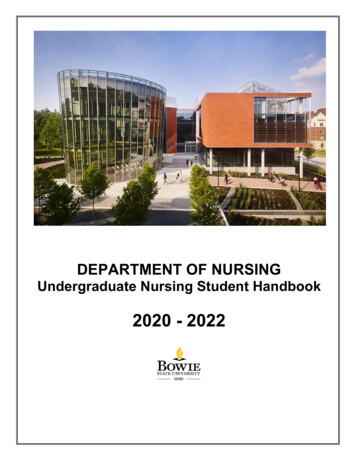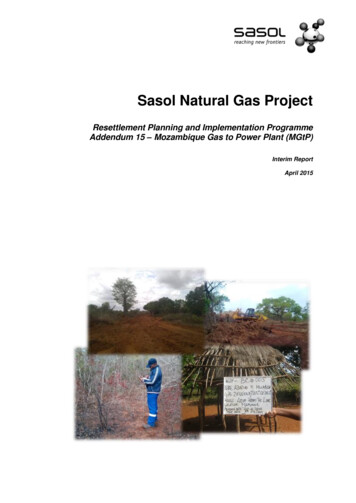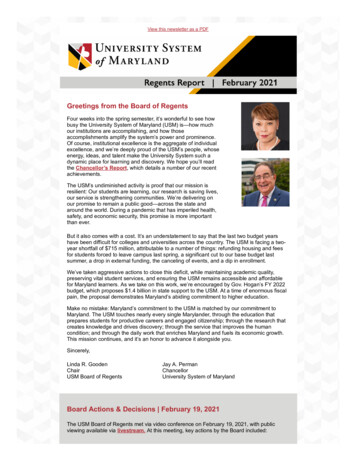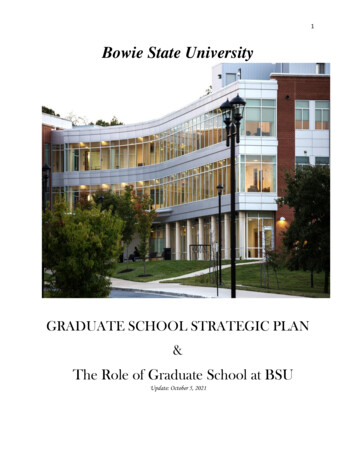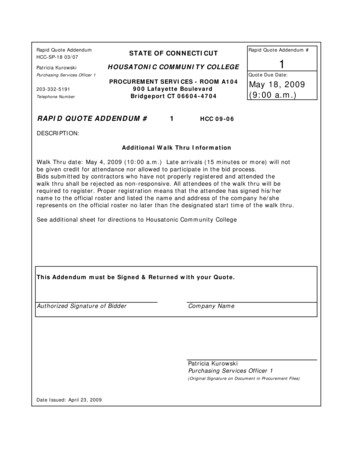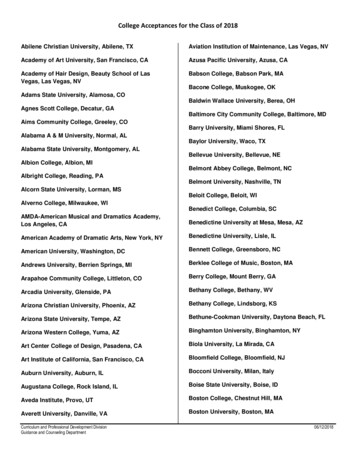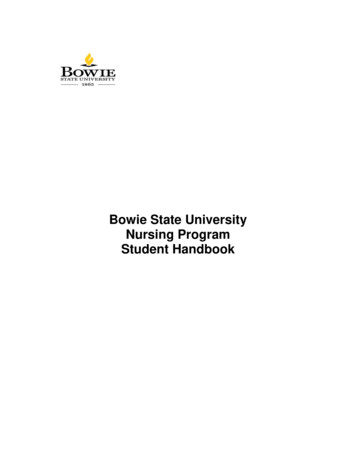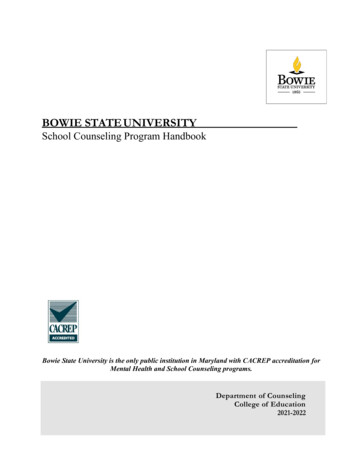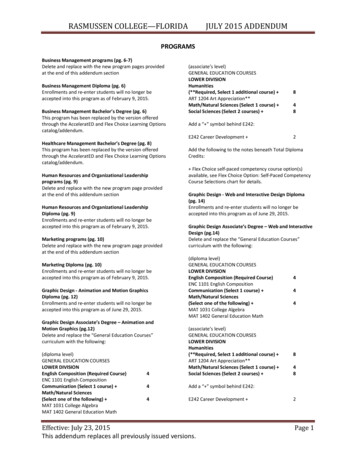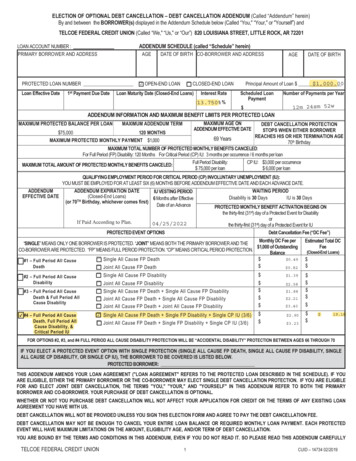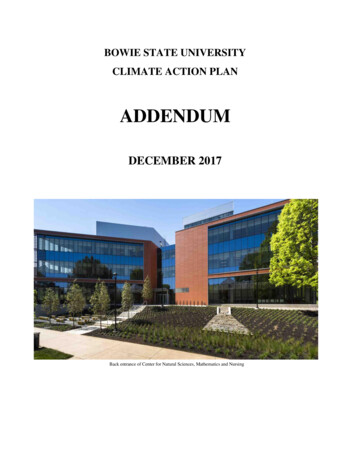
Transcription
BOWIE STATE UNIVERSITYCLIMATE ACTION PLANADDENDUMDECEMBER 2017Back entrance of Center for Natural Sciences, Mathematics and Nursing
Addendum: Table of ContentsRevised December 2017Executive SummaryChapter 1. Administrative GuidelinesChapter 2. Energy Conservation and Power SourcesChapter 3. TransportationChapter 4. Education, Training and ResearchChapter 5. Funding the PlanChapter 6. Goals and RecommendationsChapter 7. ResilienceAppendix I White House Climate Pledge Signature pageAppendix II Second Nature Climate Leadership StatementAppendix III Perception of Climate Resilience –Key Findings (Prince George’s County)2
EXECUTIVE SUMMARYThe current Bowie State University president, Dr. Aminta H. Breaux (July 2017 - Present) hascommitted to continuing the University’s mission in decreasing the carbon footprint of Bowie StateUniversity and the surrounding community. As outlined in the Bowie State University InstitutionalGoals and Presidential Objectives, FY 2018, Dr. Breaux specifies as one of her Presidential objectives,to ‘Continue to reduce the carbon footprint and develop sustainability initiatives that create significantreduction in Greenhouse Gases’.As President, Dr. Breaux intends to further the two pledges and commitments that formerPresident Dr. Mickey L. Burnim committed the University in 2015. Dr. Burnim in 2015 signed thenew Climate Commitment (an integration and rebranding of the ACUPCC) as a Charter Signatory.The Climate Commitment, a signature program of Boston-based nonprofit Second Nature, will requireBowie State University to set climate targets, report on progress publicly, and collaborate with thesurrounding community, all while integrating sustainability across the curriculum. The ClimateCommitment is one of three commitments from Second Nature. These are known jointly as the ClimateLeadership Commitments, and include a Carbon Commitment (focused on reducing greenhouse gasemissions), a Resilience Commitment (focused on climate adaptation and building communitycapacity), and a Climate Commitment that integrates both. The Carbon Commitment, formerly knownas the American College & University Presidents’ Climate Commitment (or ACUPCC) has been usedas a model for higher education climate action internationally. The Climate Commitment seeks toexpand on that success and integrate resilience into the framework.On November 19th, 2015, the White House launched American Campuses Act on Climate3
(ACAC) initiative to amplify the voice of the higher-ed community in support of a strong internationalclimate agreement in the United Nations COP21 climate negotiations in Paris. Dr. Burnim also signedthis agreement, whose pledge reads:“As institutions of higher education, we applaud the progress already made to promote clean energyand climate action as we seek a comprehensive, ambitious agreement at the upcoming United NationsClimate Negotiations in Paris. We recognize the urgent need to act now to avoid irreversible costs toour global community’s economic prosperity and public health and are optimistic that world leaderswill reach an agreement to secure a transition to a low carbon future. Today our school pledges toaccelerate the transition to low-carbon energy while enhancing sustainable and resilient practicesacross our campus.”When the federal government decided to withdraw from the Paris Agreement under directionof President Donald Trump, a new movement called ‘We Are Still In’ was created. Bowie StateUniversity along with over 1200 other colleges and universities, governors, mayors, business andinvestors sent a message to the international community that in lieu of US federal support, we willcontinue the U.S. commitment to address climate change and continue to support the U.S. in remainingto be a viable global leader in reducing carbon emissions.4
Chapter 1. Administrative Guidelines [updated]Team MembershipListed below are the members who serve on the Climate Commitment CoordinatingCommittee (C4), as of December 2017:Dr. Karl Brockenbrough, Chair, Vice President for Administration and FinanceJabari Walker, Staff, Administration and FinanceDr. Alan Anderson, Department Chair of Natural SciencesDr. Darsana Joysula, Faculty, Computer Science DepartmentDarryl Williford, Director of Facilities ManagementDr. Jacqueline Jackson-Palmer, Staff, Facilities ManagementDr. Regina Tawah, Faculty, Accounting, Finance and Economics DepartmentPatricia Hughes, Faculty, Computer Science DepartmentDr. Steve Sheffield, Faculty, Natural Science DepartmentDr. William Lawrence, Faculty, Natural Science DepartmentDr. Felicia Valdez, Faculty, Technology, Learning and Professional DevelopmentCurtis Carr, Staff, Auxiliary ServicesApril Stevens, Staff, Residence LifeJerry L. Isaac, Staff, Continuing EducationJatina Cooke, Staff, Auxiliary Services5
Nichole Isaacs, Staff, Facilities ManagementSGA RepresentativesGSA RepresentativesStudent Green AmbassadorsWithin Four-Nine Years (2013-2018) Establish a student led green ambassador program affiliated with C4 with a strong focuson student awareness and activities Establish student green fund to help provide funding for student led green initiatives andprojects Establish a sustainability website that includes a link for students and campuscommunity to give ideas and feedback on sustainable projects on campus Establish social media presence for Sustainability/C4 Create an infrastructure on campus that utilizes an alternative energy source oralternative energy sources (i.e. solar power) that will help achieve a minimum of 10%reduction of conventional power resources and will help reduce carbon footprint Increase sustainability awareness through unique student events such as Earth weekactivities Work with campus community to achieve minimum LEED Gold certification on newlybuilt or designed buildings Implement an electronic/paperless system of campus-wide approval procedures (i.e. HRhiring process; Conference Services requests and reservations, student tuition payments)6
Increase number of fuel efficient vehicles on fleet and on campus Increase student and staff participation, recognition, and professional developmentopportunities in relevant institutional sustainability associations and organizations (i.e.AASHE) Increase and enhance Recycling program efforts on campus (i.e. purchase of recyclebins, fun activities to encourage recycling, and enhance Recyclemania program) Create campus informational video on sustainability as means of awareness; increase visibilityon BSU campus and surrounding community of environmental protection andpreservation actions of C4 and sustainability program Establish community collaboration efforts and participation in community greenactivities Establish campus garden and Garden committee Assist in efforts of creating a permanent student led program to assist in continuouscampus beautification and clean up efforts Create a Hazard/Disaster Mitigation Coalition; Draft a hazard mitigation plan to satisfythe requirements of the Resilience Commitment component of the new ClimateLeadership CommitmentWithin Ten-Fourteen Years (2019-2023) Establish an annual student work study job or annual paid internship (called ‘GreenStudent Intern’) Create a composting program7
Establish a campus garden and Garden Club/committee to ensure the maintenance andsuccessful sustainability of the garden Install several electric charging stations around campus for electric passenger vehicles Continue to increase alternative energy source means on campus to help provideelectricity and reduce reliability on conventional methods Increase strategies on campus to drastically reduce usage of paper; increase digitalizedmethods of record keeping and storage Greatly reduce or eliminate usage of plastic bottle on campus (re-examine vendormethods for cutting the use of plastic bottles)8
Chapter 2. Energy Conservation and Power Sources [updated]The operations section contains eleven sub-sections covering a wide range of activities.The long term vision is that BSU will conduct all aspects of campus operations in a fashion that isecologically sound, socially just, and economically viable. The sub-sections and associated goals are:Electrical Energy Management and Conservation: Become an institutional role model forelectricity conservation through the rigorous implementation of emerging technology to increaseefficiency, and the application of policy-based conservation practices to reduce waste. Our goal isto reduce overall electrical consumption 20% from 2006 levels by 2022.Campus Heating: Reduce the annual consumption of fossil fuels for heating by 20% from 2006 levelsby 2022.Sustainable Energy: Become less dependent upon fossil fuel energy for electricity, heating andcooling.Storm Water Management: Reduce the amount of total suspended solids coming off the campusby 40% before 2022 (from 2006 baseline).Facilities Planning, Renovations and Construction: Utilize energy efficient and sustainable designstandards on all new construction and applicable renovation projects undertaken after 2012. As ofthat deadline, all construction and renovations projects shall seek to meet or exceed LEED “Silver”level of sustainability pending capital funds availability, but with a preference of LEED “Gold”.Purchasing: Develop and follow sustainability-focused purchasing policies in more than 50% ofspending for campus materials and equipment by 2022 by instituting a shared supply system.Water Conservation: Utilize Energy Performance Contract to have low flow water faucets andlow flow toilets in most campus buildings. Retrofit water fountains to reduce waste of plastic water9
bottles as well as limit wasteful use of water from fountains. *See also solid waste management inthat retrofit fountains should reduce usage of plastic water bottles across campus.Solid Waste Management: Reduce production of municipal solid waste by 30% from 2006 levelsby 2022 by working in conjunction with Facilities Management and Food Services to enhance solidwaste and recycle programs. Increase recycle bins in common areas of academic buildings. Expandrecycle efforts to include all recyclables including cardboard. Expand recycling incentives such asRecyclemania to include all buildings on campus and participate in nationwide competitions. Installa series of solar trash compactors which: save space by compacting solid waste automatically whenreaching full, utilizes 100% solar energy, and limits trips to empty bins which can save gas as well asmanpower.Greenhouse Gas Inventory and Reporting: Reduce greenhouse gas emissions campus wide. Themost recent, up to date summary is included in appendix IV.Food Services: Minimize the environmental and social impacts of operations including indirectimpacts of suppliers while continuously providing a variety of nutritious and sustainably-grownfoods by possibly establishing campus community garden. Create a team/committee to explore thefeasibility of composting by 2019.Grounds/Maintenance: Increase biodiversity and usable green space of the campus whilereducing dependence on fossil fuels, other extracted minerals, chemical fertilizers and pesticides.Increase student participation in keeping campus clean and green throughout the school year.Create proposal for a functioning long-term garden primarily run by students.10
Chapter 3. Transportation [updated]Transportation to and from Bowie State University (BSU) is a significant contributor to thecampus’ carbon footprint as well as the region. As shown in the below table, BSU issued 3,189 parkingpermits for FY 2017. BSU also operates a fleet of vehicles for Public Safety, Maintenance, Athletics,and staff transportation.Parking Permits issued for Bowie State University Fall 2016ClassificationNumber IssuedType of PermitIssued1Fall Semester, Only – students300CCommuter Students (full-time)1800RResident Students300FFaculty308Reserve Faculty/Staff93RESSTOTALStaff3883,189Faculty, staff and students commuters utilize various methods to commute to campus.Currently approximately 96% of staff and 61% of faculty drive their personal vehicles to campus.Of the approximate 6,100 students enrolled at BSU, about 2,400 are currently authorized to driveand/or park a vehicle on campus. The committee estimated these numbers based on parking permitdata from the Department of Campus Safety. The University has not yet seriously encouraged theuse of public transportation, but should explore new avenues and methods to encourage diverseoptions that will assist employees and students to lower their carbon footprint. The parking demandhas significantly increased over the past 4-12 months.11
MAGLEV/MARCThe MARC train still proves to be a viable option for travel for employees and students fromthe Baltimore or DC areas to campus. The proposed MAGLEV (magnetic levitation) may allow foreven faster travel from Baltimore to Washington DC with a proposed stop at BWI Airport, whichcould allow another option for transportation. The “Baltimore-Washington Superconducting MaglevProject” is now in the stages of preparing an EIS (Environmental Impact Study) to evaluate thepotential impacts of constructing and operating a high-speed superconducting magnetic levitationsystem in the metro area.Impacts from energy efficient vehiclesDue to steady enrollment growth, stable gas prices, and campus remote location, it does notseem likely that the number of actual vehicles will decline significantly in the coming years, howeverit is likely that the type of vehicles on campus can be altered to be more environmentally friendly. TheUniversity currently allows personal vehicles that meet the Energy Efficient Qualifying VehicleInformation according to the American Council for Energy-Efficient Economy (ACEEE) website(www.greenercars.org) to receive a 20% discount in the cost of permit if the vehicle scores a 40 orhigher. The University website is: -16-parkinginformation-2.pdf. This information should be advertised with the assistance of Campus Safety(Division of Student Affairs) and promoted on a wide scale across campus so that vehicle owners areaware of the incentive, and with hopes that this incentive will encourage others to consider these typesof vehicles when purchasing their next vehicle.BSU has been exceptional with the number of electric and hybrid vehicles in it’s fleet. The12
Transportation Department currently has two electric carts, one flex fuel sedan and one flex fuel 7passenger van. The carts are charged using the electric charging station and vehicles are fueled byusing the on-site gas tank. The Facilities Management Department has three electric vehicles. TheAthletics Department has ownership of a Toyota Rav4, which is a hybrid vehicle through contractwith the CIAA. While the number of electric and hybrid vehicles are commendable, there are stillplenty of cars on fleet that still utilize old fuel-efficient methods, such as Facilities. Alternative fueledvehicles should be considered for all new vehicles purchases from the contract. There should be a planput in place to replace these vehicles within 5-7 years.Infrastructure Strategies to help lower carbon footprintOne way to decrease the number of cars on campus and traveling to campus is to make moreoptions that are residential available on campus. The University administration is currently in thebeginning phase of planning a new residence hall that will help reduce the number of students whoare forced to stay off campus and drive. Another way to decrease the carbon footprint is to reduce thetime spent of multiple vehicles spending several minutes searching for available parking spaces oncampus. This constant circling creates a loss of class and/or work time, but also causes more harmfulgases to be emitted into the atmosphere. Therefore, the University is also currently in the preliminarystages for planning the constructing of a 400 space parking lot to accommodate and greatly alleviatethe massive influx of cars on campus.Impacts from alternative modes of transportationThe emergence of programs like ZipCar are beneficial to the University in that it provides thecampus community with alternative means to commute locally and even encourages students tocarpool at minimal cost. Zip cars are hybrid vehicles which overall use less gas. Zip Car, Inc also13
uses an electronic based system for their business transactions with customers. There are four zip carscurrently in use on campus parked in front of the Student Center. This number should be increased inthe coming years to be included at other buildings, especially as the enrollment grows.The increase of manufactured electric vehicles should indicate the need of the University topurchase electric charging stations. BSU is currently working with the Maryland Department ofTransportation (MDOT) through the assistance of the Volkswagen Group of America to bring electricvehicle charging stations to campus. The goal of the collaboration is to invest in electric vehicle (EV)charging infrastructure and increase availability of chargers, particularly in highly dense metropolitanareas. There are currently four sites (Lot A, Lot D, Lot E, Lot J) proposed (assuming two stations perlot) on the Bowie State campus. Tied with the Muirkirk MARC Station, Bowie State has the highestnumber of proposed outlets. See table below from the ZEV Investment Funding Proposal submittedby MDOT in June, 2017.14
Bicycle/Pedestrian methodsBicycles are another growing trend in the Washington DC metropolitan area, a means that somecampus residents may utilize. All residence halls now contain bicycle racks, as well as most academicbuildings including 10 in front of the Center for Natural Sciences, Mathematics, and Nursing(CNSMN). The BSU Bicycle club was created in 2015, but membership is low since most students inthe club do not own bikes. The Bicycle Club could serve as a catalyst to begin a small bike shareprogram on campus, particularly beneficial to those who reside within a 5 mile radius of campus. C4could assist with helping to provide and secure funding as well as visibility to the program.Bowie State recognizes the benefit of pedestrianism as it pertains to one’s personal health aswell as the elimination of harmful carbon gases. The University should collaborate with localmunicipalities to help local residents to use pedestrian paths through our campus. The cuurent Trail15
Easement Agreement between Bowie State and the Maryland-National Capital Park and PlanningCommission (M-NCPPC) will result in the extension of the existing Washington, Baltimore andAnnapolis (WB&A) Trail, which is currently used by the public for pedestrian access, biking, and othertrail related activities.16
Chapter 4. Education, Training and Research [updated]The long-term vision is to continue to link the university’s formal teaching mission andinformal teaching opportunities to develop understanding, attitudes and habits that promotesustainability. This section of the plan suggests a variety of ways that BSU can improve the way thatit teaches sustainability, both inside the classroom and outside of it. The sub-sections and associatedgoals are:Curriculum: While Sustainability is still not considered to be a mandatory guideline orrequirement by the Maryland Higher Education Committee (MHEC), several BSUinstructors have opted to include environmental, health related, and other forms ofsustainability into their curriculums. C4 (in particularly C4 Faculty members) shouldcontinue to push Sustainability as a requirement to be met for at minimum the GeneralEducation required courses. Students should have extensive and diverse opportunities tostudy sustainability in their coursework. Professional Development opportunities should befrequently sought after and commissioned for BSU faculty to better enhance theirknowledge of sustainability methods and how to teach or introduce them in the classroom.New Academic Buildings:The classroom building in its design and function should be a main catalyst for studentengagement and learning.The environment should be conducive, convenient andcomfortable to not only learn more about climate change or sustainable practices, but to beable to practice such by utilizing modern technology void of paper and writing devices, andby the latest technology in science, nursing and business practices. The building itselfshould utilize energy saving methods to greatly reduce the campus carbon footprint and to17
avoid wasteful energy and costs. The CNSMN contains retrofitted water fountains,recycle/trash receptacles throughout the building, a rooftop greenhouse, dynamic glazing,active chilled beam systems, computerized building controls, storm water management andmulti-parameter demand control ventilation.All future building on the Bowie State Campus should meet or exceed the functions andfeatures of the CNSMN.Campus Events: Continue to encourage active participation in annual Earth Daycelebrations, Recyclemania competition, Shred Day, and institute a campus-wide mandatefor all active BSU student organizations in keeping the campus clean and beautiful and trashfree, and also serve as a source of community service.Internships, Service Learning and Volunteering:The Green Ambassador Program was created as part of C4 in 2013 to help train and recruitstudent volunteers to be ambassadors among the student body in sustainability practices. Afuture goal should be to explore the feasibility of funding one or two student interns annuallycalled ‘Green Student Interns’ to help create, coordinate, promote, participate in, manage,and spread awareness of environmental conscious practices across campus. These studentinterns could even play a role in the development and functionality of future infrastructureon campus.18
Chapter 5. Funding the Plan [updated]In addition to the existing Student Green Fund which is derived from undergraduate andgraduate fees, discussions could also be undertaken with the Division of Institutional Advancementand Office of Research and Sponsored Programs to find additional funding for projects on campus andto assist in establishing and maintaining a permanent, paid ‘Green Student Intern’ position on anannual basis.19
Chapter 6. Goals and Recommendations [updated]The Campus Sustainability Plan is comprehensive and ambitious, and includes manyrecommendations for initial consideration, within a nine year period, and future consideration.While all of the recommendations would help make BSU more sustainable, some are critical,especially as we begin the process of implementation. Below is a list of those crucial tasks.1) Perform Energy Audit and Implement Recommendations2) Encourage the Infusion of Sustainability Teaching into BSU core curriculum3) Increase awareness on Sustainability, Residence Hall Programs on Sustainability4) Develop Community Garden and Composting Site5) Adopt LEED Gold standards for new construction and minimum LEED Silverstandards for renovation projects (as funds allow) with goal of achieving one LEEDPlatinum building6) Perform annual action plan progress review20
Chapter 7. Resilience [*new*]Significant climate change impacts are projected and impacts over the next few decadesare virtually certain and Universities are part of the “front line” for dealing with climate change.Bowie State University recognizes that mitigation and adaptation are complementary strategiesfor reducing the likelihood of unmanageable change, managing the risks and taking advantageof new opportunities created by our changing climate.In 2006, the ACUPCC was signed by former President Mickey Burnim a milestonesignature accomplishment of Bowie State University in its long term commitment to climatechange reduction.In October 2015, the presidents on the Climate Leadership SteeringCommittee worked with Second Nature (a nonprofit membership oriented organization thatworks with colleges and universities to expand efforts on environmental sustainability) torebrand the ACUPCC. The new re-branding consisted of a Resilience component.Climate resilience has been described as the “ability to survive disruption and toanticipate, adapt, and flourish in the face of change”. In 2016, former President Mickey Burnimsigned the new agreement called the Climate Leadership Commitment. [Appendix II] Campusessuch as Bowie State University that address the climate challenge by reducing greenhouse gasemissions and by integrating resilience into their curriculum, research, and campus operationswill better serve our students. Carbon neutrality and resilience are extremely high priority areasof action for all institutions.Building resilience to climate change impact is a relatively contemporary endeavor,compared to the ongoing mitigation efforts globally. Such efforts have been underway to reducethe impact of human activity on the climate. These efforts were primarily centered around21
mitigation strategies with a focus on reducing and preventing emission of greenhouse gases.Mitigation efforts however are focused on long term reduction of GHGs which might takedecades to have an observable impact. The primary goal of the resilience commitment is todevelop an action plan to increase resilience. This chapter will focus on two primary areas toaddress resilience: the Bowie State University Environmental Resilience Plan, which includeshazard mitigation and Community collaboration/partnership.Proposed Action Plan set forth by Second Nature:Resilience Commitment:1) Develop a Climate Action Plan to increase resiliencea.Within two months of signing this document, create internalinstitutional structures to guide the development and implementation ofthe Planb. Within one year of the implementation start date, actively support ajoint campus- ‐ community task force (or equivalent) to ensurealignment of the Plan with community goals and to facilitate jointaction, and submit the first annual evaluation of progressc.Within two years of the implementation start date, lead and complete aninitial campus- ‐community resilience assessment including initialindicators and current vulnerabilityd. Within three years of the implementation start date complete the Plan,(also reflecting joint community- ‐campus components), which willinclude: A target date by which defined thresholds of resilience will be met22
Interim target dates for meeting milestones that will lead toincreasing resilience** Mechanisms and indicators for tracking progress (including thosethat cut across campus- ‐community boundaries) Actions to make resilience a part of the curriculum and othereducational experiences for all students e.Actions to expand research in resilienceReview, revise if necessary, and resubmit the climate action plan notless frequently than every five years2) Submit an annual evaluation of progressa.Within one year of the implementation start, and every year thereafter,complete an annual evaluation of progressb. Make the action plan and annual evaluation of progress publiclyavailable by submitting them to the Second Nature Reporting Systemfor posting and disseminationBowie State Environmental Resilience Plan (BSU-ERP)The process to develop the BSU-ERP will initiate once a committee is set up, which isscheduled to begin in the early part of 2018 with a goal of completion by the end of the 20172018 academic/fiscal year. The primary stakeholders at Bowie State University tin the planningprocess would consist of Facilities Management and Grounds, and Capital Projects. CampusSafety will also have a secondary role. The BSU-ERP will have cross sections of two localexisting plans (City of Bowie and Prince George’s County).Bowie State University is located in Bowie, Prince George’s County, Maryland. Two23
plans that will be reviewed and analyzed f will be: 1) the City of Bowie Emergency OperationsPlan (2016), and 2) the Prince George’s County and City of Laurel Hazard Mitigation Plan (2010).1. City of Bowie: The City of Bowie does not have a separate Hazard MitigationPlan. The hazard mitigation information section provided below is in its currentEOP. However, the information is very limited. One consideration is to team upwith the City of Bowie to assist each other in creating a more comprehensive plan.See below excerpt from plan taken from website File/Item/1732X.Hazard MitigationA. General The primary goal of mitigation is to reduce loss of life and property by lesseningthe impact of disasters. This is achieved through regulations, local ordinances,land use and building practices, and mitigation projects that reduce or eliminatelong-term risk from hazards and their effects. Mitigation, by reducing theimpacts of a disaster, will also lessen the demand for resources in the event ofanother disaster. In the event of a Federal Declaration of a major disaster for the State ofMaryland, Prince George’s County may be eligible to apply for HazardMitigation Assistance under the federal Hazard Mitigation Grant Program(HMGP). The HMGP provides grants to State and local governments to implementlong-term hazard mitigation measures after a major disaster declaration. In addition, if Prince George’s County is included in a Federal Major DisasterDeclaration that includes public assistance, hazard mitigation funding may beavailable through the public assistance program under Section 406 of the RobertT. Stafford Act. Departments and agencies engaged in repair and restorationwork should consider mitigation methods that will prevent or reduce damage infuture incidents for potential funding as part of this program. This publicassistance program is managed by MEMA.24
Eligible applicants include state agencies, local governments, and privatenonprofit organizations which own or operate facilities providing essentialgovernment services.City of Bow
Transportation to and from Bowie State University (BSU) is a significant contributor to the campus' carbon footprint as well as the region. As shown in the below table, BSU issued 3,189 parking permits for FY 2017. BSU also operates a fleet of vehicles for Public Safety, Maintenance, Athletics, and staff transportation.
